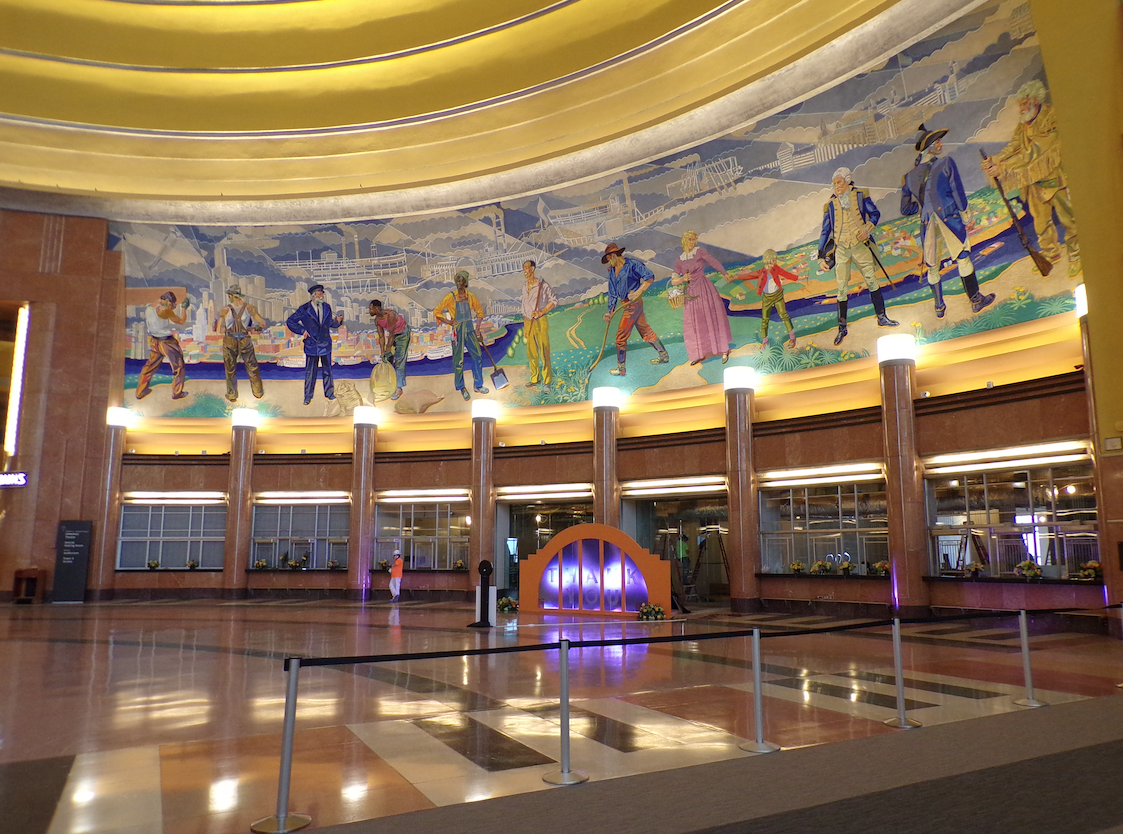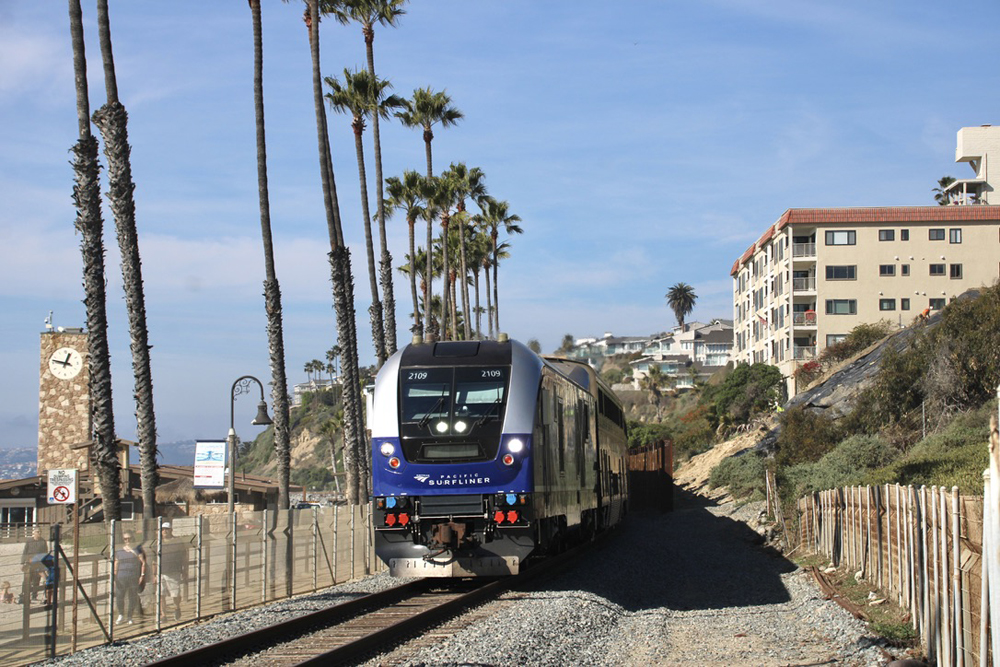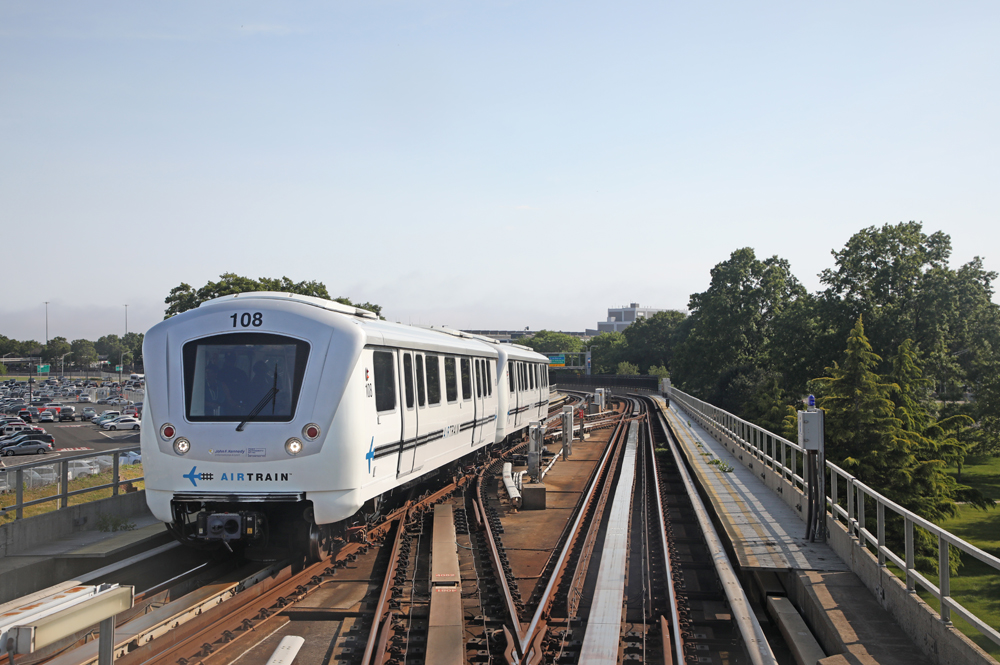The building today is home to several museums and is a night time stop on Amtrak’s tri-weekly Cardinal.
The restoration project was funded by a sales tax passed by Cincinnati and Hamilton County, Ohio, voters in 2014.
“Construction began in July 2016 after a little more than a year of probes and analysis by architects, engineers, and conservators” says Cody Hefner, a representative of the Cincinnati Museum Center, the terminal’s caretaker. “We have carried on and protected the legacy of the craftsmen who poured their blood, sweat, and tears into the building during its original construction from 1929 to 1933.”
The restoration work was extensive, going all the way down to the building’s substructure, with the intent that the 85-year-old building will be able to last at least another 100 years. The classic murals in the rotunda were painstakingly restored to the way they appeared when the building opened to the public in 1933. Even the classic, neon-lined clock on the front of the building was given a complete overhaul.
“This is a monumental achievement for our staff and volunteers and for the entire community” Hefner says. “Everyone who works here, and really everyone in the community, has a story about Union Terminal, either as a train station or as a museum. So to be able to restore a place with such a personal connection, and to do so in such a grand, visible, breathtaking way, is really incredible.”
During the restoration project, Amtrak had moved its waiting room and ticketing facilities to an adjacent building, but service was able to continue uninterrupted. Amtrak moved back into the Union Terminal facilities during the first week of November.
To mark the events leading up to the full public reopening on Nov. 17, Hefner says they’ll use projectors to light up the terminal’s exterior with different exhibits each evening. A large Christmas train display will open to the public Nov. 16. The display has been a tradition at the terminal since 1946.















Wonder if the pipe organ from legendary builder B.F. Skinner has been moved or restored. Also the status of Tower A. Anyone?
I read once that the high cost of demolishing all the reinforced concrete that went into the rotunda structure was the only thing that kept CUT standing in the 1970s. As a fan of railroads, Art Deco design, and architecture, I’m glad it survived then and glad it has received a thorough rehab now. Maybe some day I’ll get to see it in person.
Great News!!!
B&O had two model railroad layouts, an “O” gauge, and an HO gauge. Which one is now at CUT and where is the other one.? They both were fascinating with working color position light signals, triple track main lines and excellent models of the B&O steam and diesel fleet.
The train display actually started at the headquarters of Cincinnati Gas and Electric located at 4th and Main in downtown Cincinnati, CG&E, later became Cinergy.. When Cinergy mergered with Duke Energy, resulting in the closure of the 4th and Main location, the display was moved to CUT. The display was constructed by the Baltimore and Ohio Railroad, and was loaned to CG&E for the Christmas display. AT some point the layout was purchased by CG&E. The layout was maintained and operated by retired employes of CG&E/Cinergy.
“Overnight stop?” Such a stop is one that lets passengers spend the night at the stop and continue their journey the next day. Cincinnati is a middle of the night stop.
https://www.cincinnati.com/picture-gallery/news/2018/11/11/look-inside-union-terminal-before-its-reopening/1912619002/
Be sure to check out all the photos. I particularly love the Rookwood art pottery tiles. So gorgeous.
CUT has always been one of the stations that, when I walk through the door, I am simply in awe of what a grand space it is! Cudos to the folks in the greater Cincinnati area who recognize what a gem CUT is and agreed to cover the renovation costs.
More information and photos at Cincinnati.com
Any word if Tower A will re-open for visitors? There have been conflicting rumors on this subject.
GEORGE PINS My memory (from reading TRAINS-MAG) is that the footbridge spanning various passenger platforms was demolished to allow for Southern Railway intermodal trains to use the space. That left only a track (or so) adjacent to the terminal. Someone more familiar with Cinncy would need to confirm something I remember reading 35 or 40 years ago.
I have a horrid memory of being dropped off at the poorly located Cinncy Amshack in 1975, when CUT was closed. Neither me nor the man driving had ever been to Cinncy and we had no idea where we were or where we were going. There was no internet or GPS in those days. Somehow we found the rotten place. Then I rode overnight in a day coach to Washington. Having been introduced to ex-Santa Fe and ex-Burlington luxury leg-rest coaches on Amtrak western trains in each of the previous three years, I was a bit put off.
To George Pins, The link below will take you to the track layout for CUT before Amtrak.
The top track is the current track that Amtrak uses and it is the only one with access from the building. The stations waitng room and concourse were above the tracks with ramps and stairs down from both side of the concourse.It was demolished and only two tracks remain
https://www.google.com/search?q=Cincinnati+Union+Station+track+layout&rlz=1C1PRFI_enUS807US811&tbm=isch&source=iu&ictx=1&fir=mHDtd1MyTFRrYM%253A%252CjSQot_gdOCJkrM%252C_&usg=AI4_-kTFtFMvorE_pIaM9j71oCe0s7Dekg&sa=X&ved=2ahUKEwiirfKS_tTeAhVm4IMKHQ0lD5QQ9QEwAXoECAUQBg#imgrc=Iy81PP2mICDKlM:
https://www.google.com/search?q=Cincinnati+Union+Station+track+layout&rlz=1C1PRFI_enUS807US811&tbm=isch&source=iu&ictx=1&fir=mHDtd1MyTFRrYM%253A%252CjSQot_gdOCJkrM%252C_&usg=AI4_-kTFtFMvorE_pIaM9j71oCe0s7Dekg&sa=X&ved=2ahUKEwiirfKS_tTeAhVm4IMKHQ0lD5QQ9QEwAXoECAUQBg#imgrc=mHDtd1MyTFRrYM:
This would be really nice if there was actually some sort of reasonable passenger service at this terminal instead of the joke service it now has.
Could someone familiar with the present and historical arrangements explain where the train platforms were originally, where they are for Amtrak now, and what has been demolished and what remains, other than the magnificent restored headhouse?